The resonance frequency of a magnetic buzzer is a critical characteristic that influences its sound output, pitch, and overall performance. Several factors influence this frequency, and tuning it for specific applications requires careful consideration of these factors. Here’s a breakdown:
Diaphragm Characteristics
Material: The material of the diaphragm plays a key role in determining its resonant frequency. Materials with different stiffness and density will vibrate at different frequencies. For example:
Stiffer materials (e.g., metal) tend to have a higher resonant frequency.
Softer materials (e.g., plastic) often have lower resonance frequencies.
Thickness: The thickness of the diaphragm impacts its mass and stiffness. A thicker diaphragm will generally have a lower resonance frequency, while a thinner diaphragm will yield a higher frequency.
Size: The size of the diaphragm directly affects the resonance. Larger diaphragms have a tendency to vibrate at lower frequencies, while smaller diaphragms vibrate at higher frequencies.
Magnetic System (Coil and Magnet)
Magnetic Field Strength: The strength of the magnetic field produced by the magnet influences the force exerted on the diaphragm, which in turn affects the resonance. A stronger magnetic field can lead to a more efficient movement of the diaphragm, altering its resonant frequency.
Coil Inductance: The inductance of the coil impacts the interaction between the coil and the magnetic field. The impedance of the coil affects the resonance frequency by influencing how much electrical energy is converted into mechanical movement.
Higher inductance can lower the resonance frequency.
Lower inductance can increase the resonance frequency.

Air Damping and Enclosure
Air Resistance: The air resistance around the diaphragm, particularly if it is enclosed in a casing, can significantly dampen or modify the diaphragm’s vibration. Increased air resistance generally lowers the resonance frequency, making the buzzer less efficient at higher frequencies.
Enclosure Design: The design of the enclosure around the buzzer can affect the resonance by creating an acoustic resonating chamber. If the chamber amplifies certain frequencies, it can increase the efficiency of the buzzer at those frequencies and change its overall resonance behavior.
Electrical Drive Signal
Signal Frequency: The frequency of the drive signal applied to the magnetic buzzer also affects the resonance. A signal with a frequency near the buzzer’s natural resonance frequency will result in the diaphragm vibrating more effectively, producing a louder sound. Therefore, the applied signal should ideally be close to the resonant frequency of the buzzer for optimal performance.
Voltage and Current: The amplitude of the drive signal (voltage and current) can also affect the resonance. A higher voltage can cause the diaphragm to vibrate with more intensity, potentially altering the resonance slightly due to increased mechanical forces.
Temperature Effects
Thermal Expansion: The temperature can affect both the material properties of the diaphragm and the performance of the magnetic system. For example, higher temperatures can cause thermal expansion of the diaphragm, slightly changing its stiffness and, consequently, the resonant frequency.
Magnet Performance: The strength of the magnet can also be temperature-dependent. A reduced magnet strength at higher temperatures can lead to a shift in the resonant frequency, often lowering it.
Mechanical Suspension
Suspension Stiffness: The mechanical system that suspends the diaphragm (e.g., springs or rubber mounts) affects the restoring force on the diaphragm. A stiffer suspension will increase the resonant frequency, while a softer suspension will reduce it.
Damping Materials: The addition of damping materials (e.g., foam or rubber) in the suspension or around the diaphragm can lower the resonance frequency by absorbing energy from the diaphragm’s vibration, reducing the overall amplitude at higher frequencies.
Acoustic Load
External Load: The presence of any external obstructions or acoustic loads (e.g., the surface on which the buzzer is mounted) can modify the resonance by altering how sound waves propagate. An attached surface can cause the diaphragm to interact differently with the surrounding air, which can raise or lower the resonant frequency.
Placement in a System: If the buzzer is part of a larger system (e.g., in a speaker enclosure or an automotive panel), the acoustic load created by the surrounding structure will affect the resonant frequency. This is why buzzers are often designed with specific mounting requirements.


 EN
EN  English
English Deutsch
Deutsch 中文简体
中文简体
